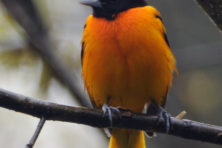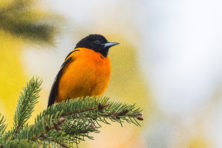Door to Nature: The Brilliant Baltimore Oriole
- Share
- Tweet
- Pin
- Share

In early May, we usually put navel-orange halves on special wooden additions that my late husband, Roy, nailed to the corners of the big platform bird feeders. The oranges attracted incoming Baltimore orioles, as well as other species such as the gray catbird, and even a scarlet tanager one year.
Now, with food prices so high, I decided to buy an oriole feeder that holds the same liquid that I place in the hummingbird feeder. Male and female orioles are using it well into the middle of June, and the hummingbirds like it also.
The orange halves were filled with grape jelly after the pulp had been eaten – then insects such as hornets and wasps were attracted to this sweet treat. The oranges became quite messy after a time, and we had to be careful not to overfill the jelly because it could get smeared in birds’ feathers and cause more problems. I remember that once the orange halves dried, we wouldn’t see or hear any orioles and thought they had moved on to other areas.
Baltimore orioles got their name from the family-crest colors of Lord Baltimore, who also gave the Maryland city its name. The birds breed into the southern parts of Canada’s prairie provinces and eastward through the southern edges of Ontario and Quebec.
They also nest in most of the eastern half of the U.S., except the Gulf and southeast Atlantic shorelines. In the western realms of their breeding areas, Baltimore orioles may hybridize with Bullock’s orioles, which are more common in that part of the country. Years ago, this occurrence caused the name of our Baltimore oriole to change to become the northern oriole. Now DNA analysis has determined that they are distinctive breeds, so we are back to the name Baltimore oriole for our eastern birds.
By late June, some of the youngsters may be leaving their beautifully woven, suspended homes. These nests are the most easily recognized of all bird structures. I remember Roy telling me about a field trip he had led near a horse farm, where he had found a beautiful oriole nest – made entirely from black horse hair from manes and tails – hanging from a tree.
Male orioles that are 3-4 years old have extremely deep orange plumage that almost glows. If you look closely at the wings of these orioles, you will see that the adult males have a single white wingbar and an orange shoulder patch.
The coloring of adult females and first-summer males (those hatched last year) can be quite variable, but they generally have two white wingbars. They may also have different amounts of orange on the underparts and black on the throat, hood and upperparts. The male orioles that are still singing in June are most likely unpaired, second-year birds that often don’t mate in their first full summer.
Few other bird species in our state can match the female oriole in nest making. What she lacks in color she makes up for in unbelievable weaving artistry. So well built are the nests that it is not uncommon for one to survive the winds and storms of three or four years before falling apart, and it’s not unusual for an oriole to use a nest for more than one summer. They have only one brood per year.
To create one of these woven masterpieces, strings are suspended, usually on a drooping branch, to form the warp. Once that framework is done, the weaving of hundreds of long, fibrous strands of plant material begins. This material can include anything that even resembles plant fibers, such as yarn or string, but fibers of grapevine, grasses, spreading dogbane, Indian hemp and common milkweed are also frequently used.
Generally, the birds enter the nests from the top, but some have a side opening. It’s possible that an additional side opening in nests that are quite deep would offer the incubating female a peephole – a window through which to look while sitting on her eggs.
There have been cold spells in May when orioles went to the suet feeder to snatch a bit of protein to supplement their diets. The young are fed insects to help them grow strong and develop wing power.
American elms had been the tree of choice for these nests, but the demise of the elms has caused orioles to find other tall trees. We find them now using maples, poplars and cottonwoods.
Lord Baltimore, what an honor it is to have one of our most brilliant singers and artistic nest builders named after you. We, too, deem it a real honor to see these gorgeous orioles brightening our summer yards and lives!



